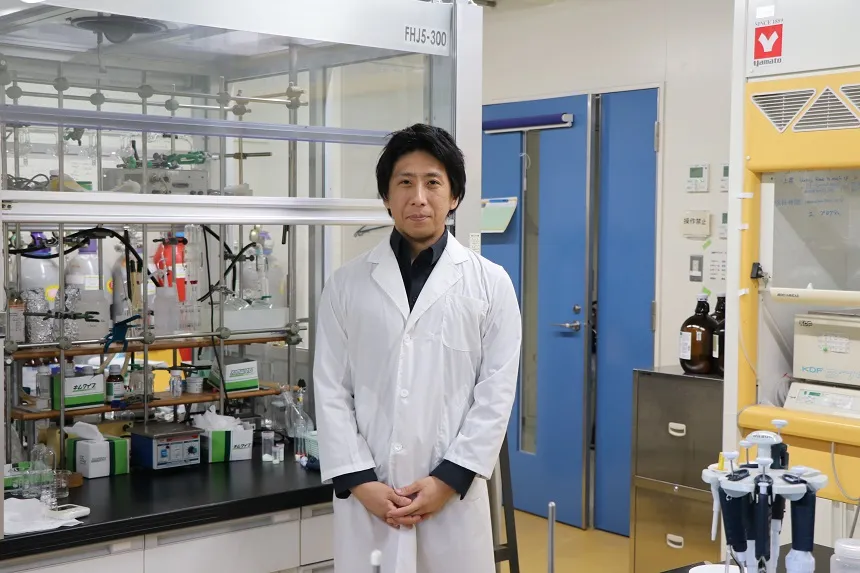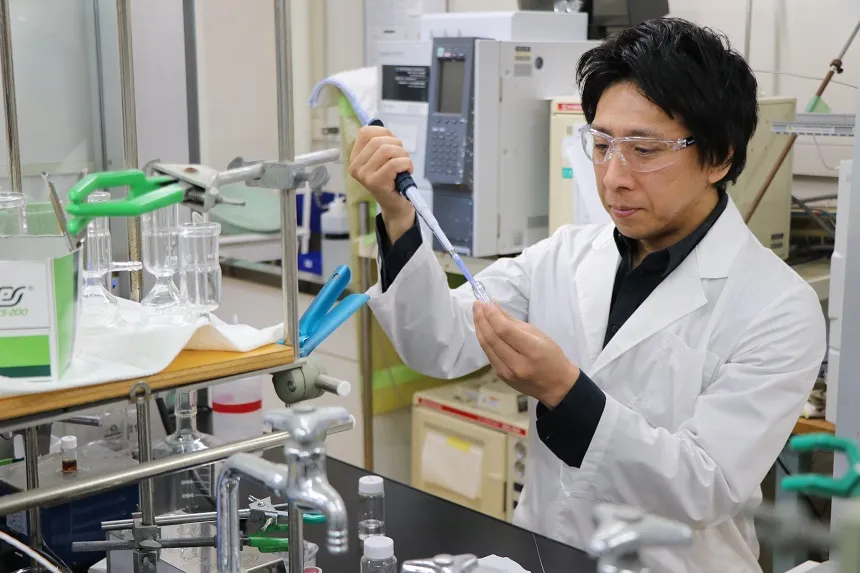Interview of Assistant Professor Takuo MINATO
Creating Brand New Materials by Conjugating large molecules with various types of metal cations as Building Blocks

| Program | JST Strategic Basic Research Programs (PRESTO) | Researchers selected in the FY | 2023 |
|---|
Integration of idea and knowledge from Inorganic Chemistry and Biochemistry
I specialize in precise synthesis of inorganic compounds, and my goal is to develop novel useful materials as designed.
The unique approach of my research is to integrate idea and knowledge from inorganic chemistry and biochemistry. In this project, I intend to isolate proteins from cyanobacteria inhabiting hot springs for the purpose of using them as nanoreactors in the synthesis of inorganic compounds. I have loved living things since I was a child, and even as I pursued a career in nanotechnology, my interest in biochemistry remained strong. Few researchers in the world simultaneously engage in fundamental research in both biochemistry and inorganic chemistry, and I believe this approach could be advantageous for me.
Conjugating Molecules Like Blocks
Currently, the research topic being pursued in the PRESTO project is “Precise sequential synthesis of giant hetero-multinuclear metal clusters with multiple elements.” The aim of this project is to create useful materials using large molecules that combine various types of elements as designed. In the precise synthesis of inorganic compounds, the process involves placing metal cations, which serve as the “core”, into “ligands,”containers. This process is similar to assembling blocks of various colors like toys. While it is easy to create an intended shape and combine block works by using blocks, synthesizing the desired structure with molecules is challenging.
Generally, when designing molecules at the nano-scale size with two or more metal cations as the core, organic molecules with carbon chain frameworks are employed as ligands. However, organic ligands possess structural flexibility, making it difficult to precisely control the position of metal cations, and they have a major drawback of being able to introduce only a small number and variety of metal cations.It was nearly impossible to synthesize large molecules of mesoscale size, ranging from 5 nm to 100 nm in diameter, as designed.
To address this challenge, I developed a method using inorganic molecules with rigid and stable structures as ligands to place specific metal cations at the designated positions within the ligand. By further developing this method, it may be possible to create giant molecules with a variety of metal cations placed at the desired positions, similar to constructing magnificent structures like castles can be built by linking together small blocks. That was the motivation behind starting this research.

Image of the synthesis of large molecules by arranging metal cations
Enable the Synthesis of Highly Active Catalysts
Previous research has led to the successful synthesis of molecules with 14 metal cations of three different types in the core, arranged as designed. I believe that connecting these molecules in large quantities could lead to their application in the development of highly active catalysts, powerful magnets, and materials crucial for recording media.
Giant molecular catalysts offer the benefit of densly arranging metal cations at the mesoscale particle size, enebling the exchange of large numbers of electrons and protons. As a result, unprecedented redox properties are anticipated, leading to the optimization of chemical processes for synthesizing, including pharmaceuticals.
In addition, by dissolving giant molecules with various types of active sites, they could be utilized as very active homogeneous catalysts due to the large number and types of active sites.
Diversifying into Molecular-Level Magnetism Research
Furthermore, I am also exploring the potential for entirely new magnetic memory materials by utilizing the magnetism of giant molecules. Conventional magnetic memories, such as hard disks, arrange very tiny magnets on their surfaces to strage digital information as binary bits (0 and 1) based on their polarity. While reducing the size of magnetic particles increases storage capacity, recent advancements have pushed particles to a limit where they no longer introduce noise, making further increases in storage capacity challenging.
The giant molecules with hetero-multinuclear metal cores that I am developing could offer a breakthrough in memory storage. By utilizing spins of electrons in each molecule, they have the potential to storage dramatically more information per unit area compared to conventional memory materials.
Materials Shaping the Future for the Next 100 Years
Many aspects of the magnetic properties of molecular-sized magnetic materials remain unknown. In addition to exploring their potential applications, I would like to study the unexplored physical properties of giant molecules at low temperatures.
I aim to advance research that integrates biochemistry and inorganic chemistry, utilizing proteins to create hetero-multinuclear metal clusters and drive them towards development. While the research is in its early stages and there is much work to be done, I hope to develop materials that will be beneficial for the next 100 years.

